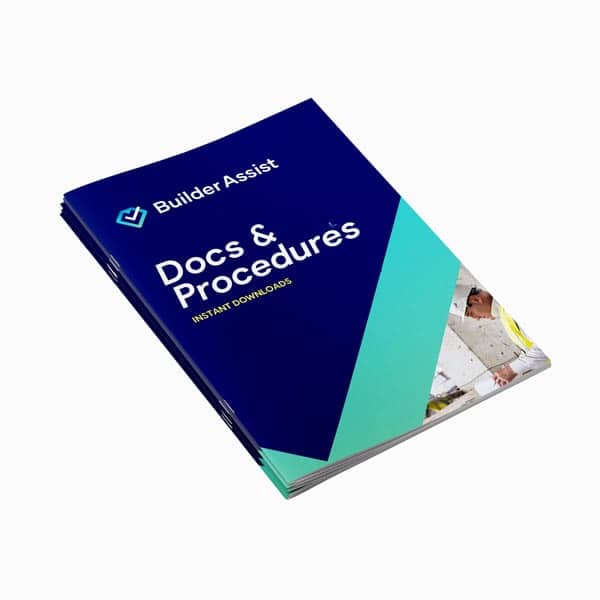
On-site safety is a day-to-day, moment-to-moment set of decisions in the construction industry, and is critical to keep you and your workmates from harm.
Two documents that help maintain safety are the Safe Operating Procedure (SOP) and the Safe Work Method Statement (SWMS).
But, the two can sometimes be confused. While they seem similar, they serve different purposes and are used in distinct ways. We break down the differences, helping you understand when and how to use each effectively.

By implementing both SOPs and SWMS, builders and tradespeople can create a safer work environment, comply with regulations, and protect their teams from harm.
What is a Safe Work Method Statement (SWMS)?
A SWMS, or Safe Work Method Statement, is a document that outlines the high-risk construction work activities to be carried out, the hazards involved, and the measures to control the risks.
Purpose of SWMS
The main purpose of a SWMS is to identify high-risk activities and ensure that all necessary precautions are taken to mitigate these risks. Importantly, it is a legal requirement for high-risk construction activities and aims to protect workers from harm.
SWMS is essential for ensuring compliance with workplace health and safety regulations. It provides a structured approach to identifying hazards and implementing controls, ensuring that all workers are aware of the risks and how to manage them.
Key Elements of an SWMS
A SWMS typically includes:
1. Description of the Work: Outline the high-risk activities.
2. Hazard Identification: Identify potential hazards associated with the work.
3. Risk Assessment: Evaluate the level of risk for each hazard.
4. Control Measures: Describe the measures to control the identified risks.
5. Implementation: Explain how the control measures will be implemented and monitored.
6. Review: Outline procedures for reviewing and updating the SWMS as necessary.
By addressing these elements, the SWMS ensures that all risks are managed and work can be carried out safely. For more information about SWMS, visit our blog: What is a SWMS?
What is a Safe Operating Procedure (SOP)?
An SOP, or Safe Operating Procedure, is a detailed, written instruction designed to achieve uniformity in the performance of a specific function. Developed for plant, machinery and equipment operation, SOPs define how to undertake tasks when operating plant, machinery and equipment. For example, an SOP is used to train a forklift operator.
Purpose of a Safe Operating Procedure
The primary purpose of an SOP is to ensure that all workers follow the same process. This consistency helps minimise the risk of errors and accidents. Moreover, by having a clear, step-by-step guide, workers can operate plant, machinery and equipment safely and efficiently. SOPs provide clear guidelines on what to do, how to do it, and what precautions to take.
Key Elements of a Safe Operating Procedure
An SOP typically includes several key elements:
1. Title and Purpose: Clearly state the task and its purpose.
2. Scope: Define who the SOP applies to and under what conditions.
3. Responsibilities: Outline who is responsible for carrying out the procedure.
4. Materials and Equipment: List all necessary materials and equipment.
5. Procedure: Provide detailed, step-by-step instructions.
6. Safety Precautions: Highlight any specific safety measures to be taken.
By including these elements, an SOP ensures that all aspects of a task are covered, and workers are well-informed about what is expected.
Differences Between SOPs and SWMS
Focus and Application
SOPs focus on the safe execution of tasks associated with operating plant, machinery and equipment, providing detailed instructions to ensure consistency and safety. They are generally used for tasks that are performed regularly and require a standardized approach.
On the other hand, SWMS focus on managing risks associated with high-risk construction activities. They are used to ensure that all potential hazards are identified and controlled before work begins.
Legal Requirements
SWMS is legally required for high-risk construction activities, whereas SOPs, while important for safety and efficiency, may not be mandated by law. Compliance with SWMS is crucial for meeting workplace health and safety regulations.
Detail and Scope
SOPs provide step-by-step instructions for operating plant, machinery and equipment safely, making them highly detailed and specific. SWMS, however, take a broader approach, identify hazards and outline control measures for various high-risk construction activities.
Conclusion
While the two documents seem similar, there are important differences between a Safe Operating Procedure and a Safe Work Method Statement. SOPs ensure the safe execution of tasks associated with operating plant, machinery and equipment, and SWMS focus on managing risks associated with high-risk construction activities. By implementing both, builders and tradespeople can create a safer work environment, comply with regulations, and protect their teams from harm.
It’s important to note that, for site safety, it’s crucial to have a current Safety Management Plan (SMP) implemented and available on-site. Find out more about SMPs in our blog: What is a Safety Management Plan? Or, you can purchase one here.

Safety Management Plans (WHS)
Specifically designed for each trade starting up a business, these Work Health Safety Management Plans or WHS Management Plans, provide support with the management of Work Health & Safety in the workplace. Also referred to as Occupational Health & Safety (OH&S) the material provided in this section will assist with WHS/OHS management and training requirements for the workplace.


